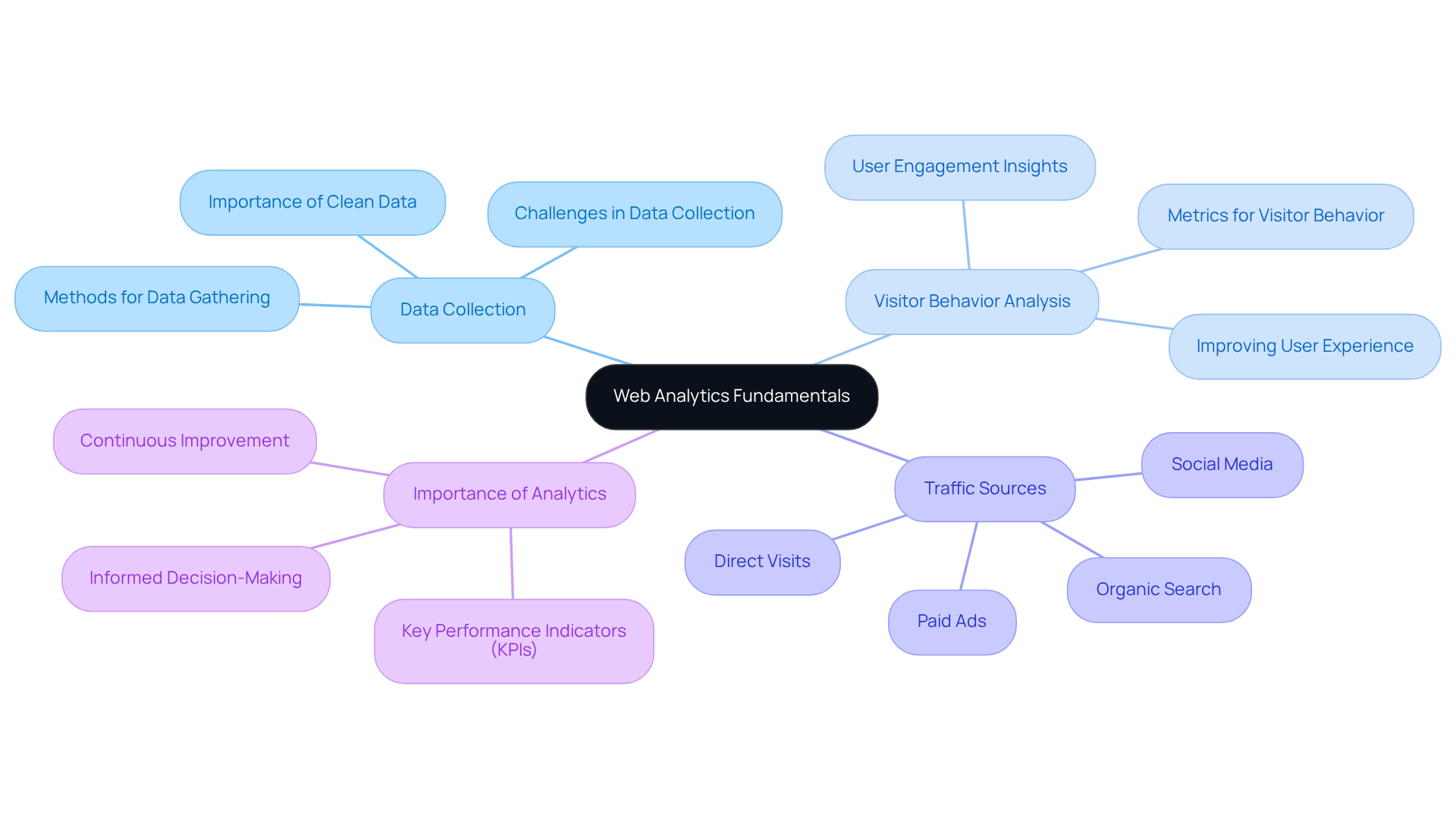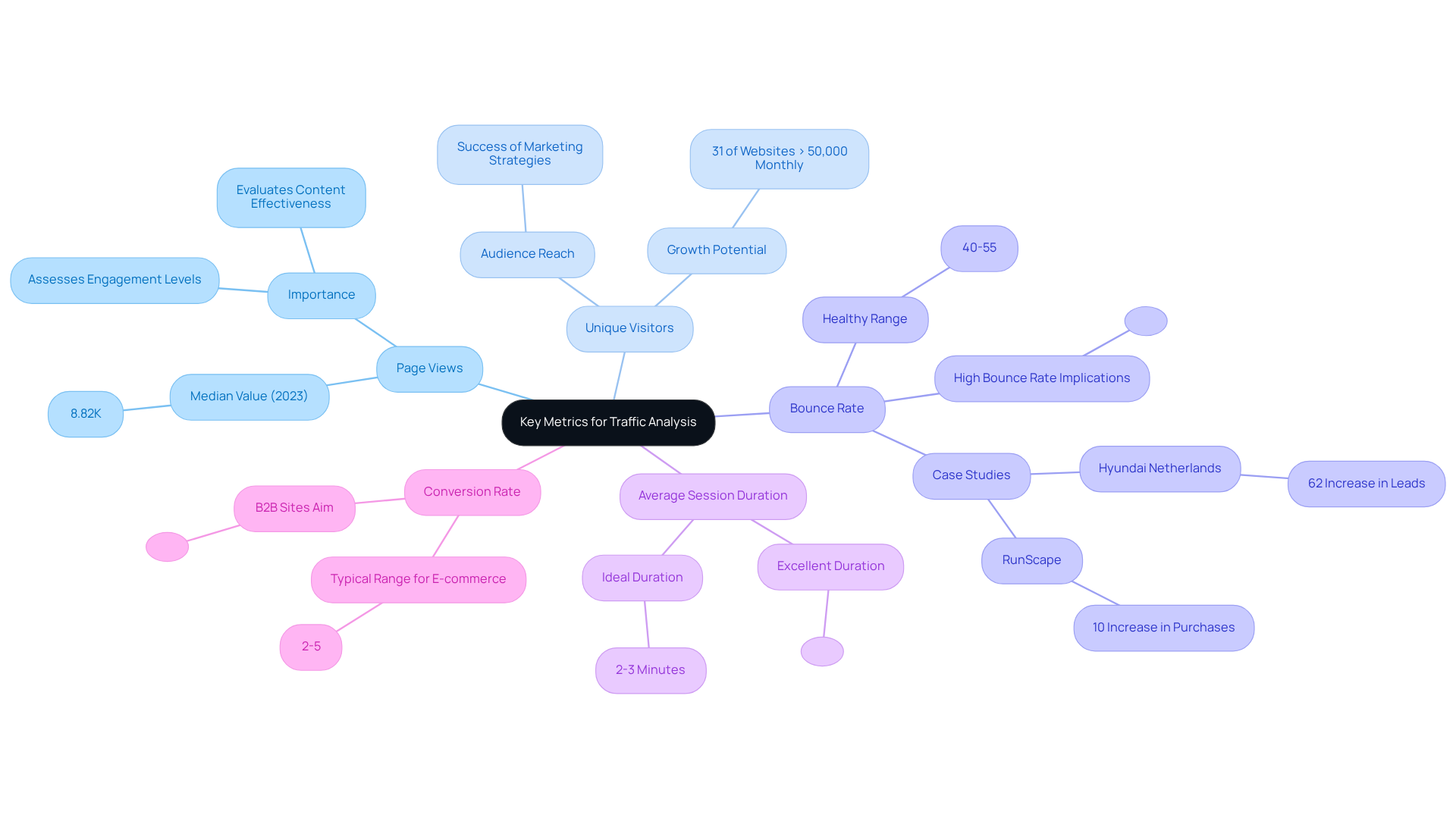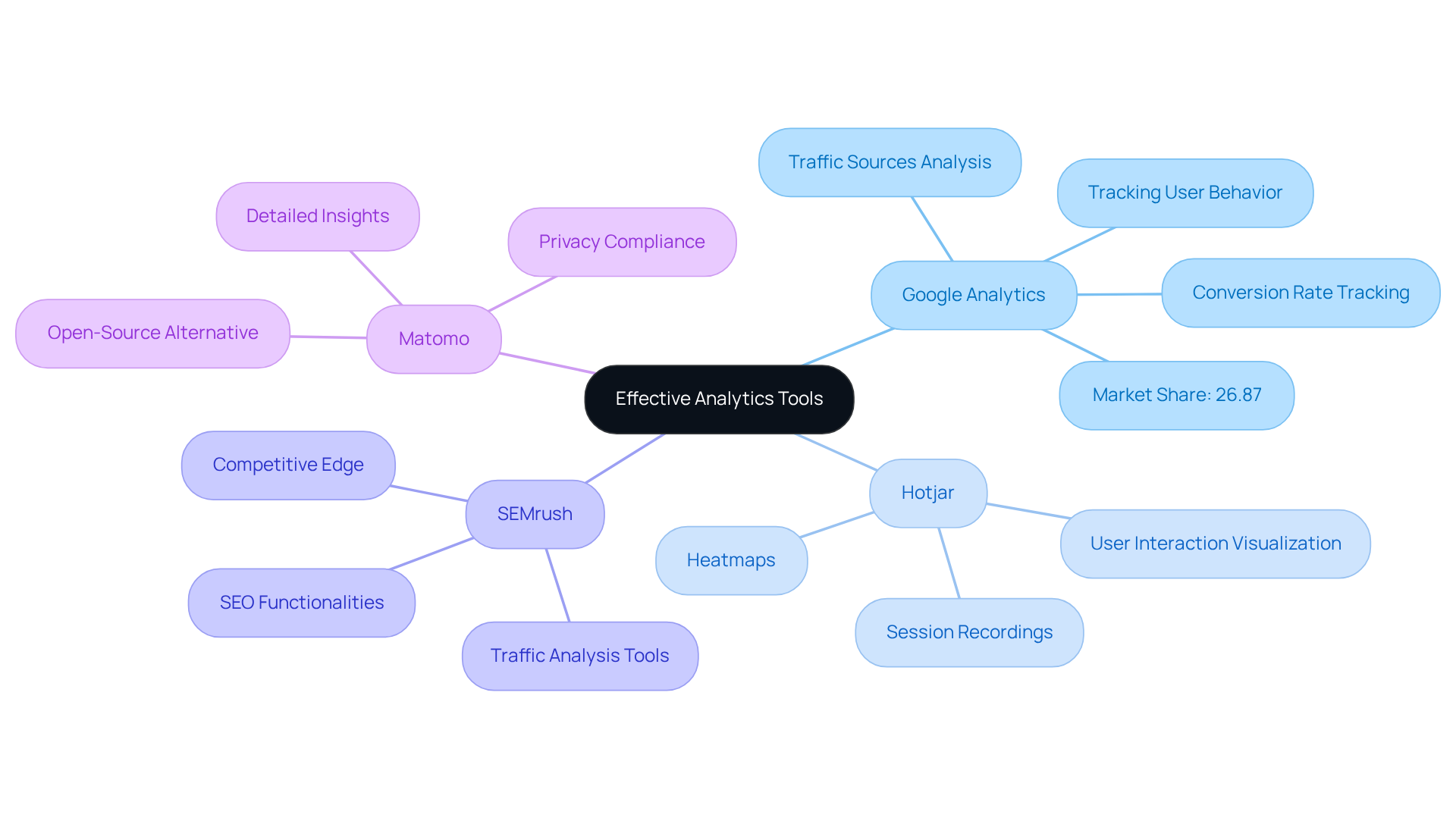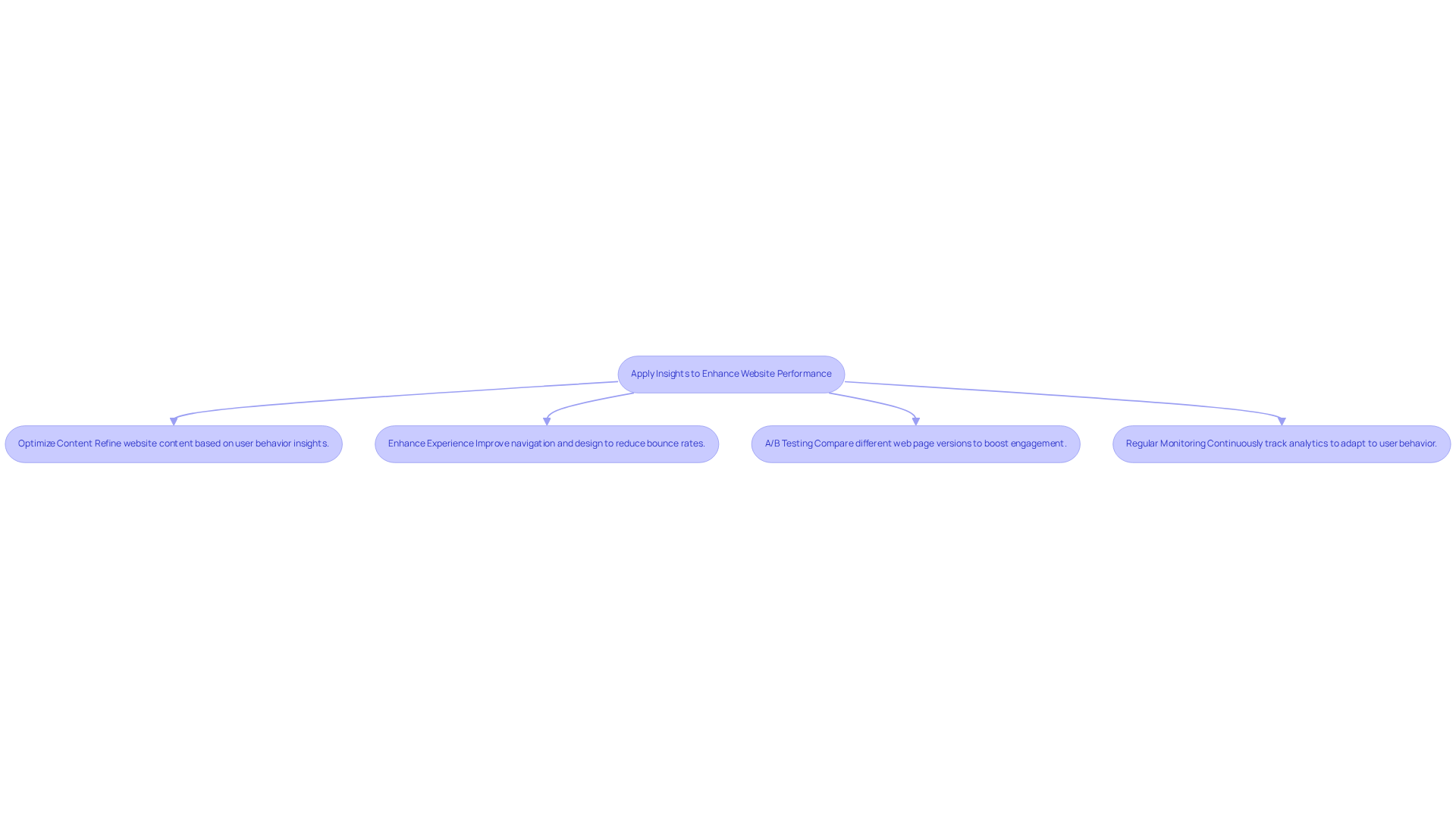Overview
In the world of website traffic analytics, many businesses struggle to navigate the complexities of data. This challenge can lead to missed opportunities and frustration, as understanding visitor behavior and key metrics often feels overwhelming.
However, there is hope. By focusing on four essential practices—data collection, visitor behavior analysis, identifying key metrics, and leveraging effective analytics tools—businesses can transform their approach.
Mastering these practices not only turns data into actionable insights but also enhances online presence and drives informed decision-making. This ultimately leads to improved user engagement and marketing effectiveness.
Embracing these strategies can feel like a daunting task, but remember, you are not alone. Together, we can foster a supportive community that empowers tech startup founders to thrive in their analytics journey.
Introduction
Navigating the complexities of website traffic analytics can feel overwhelming for many tech startup founders. It's not just about gathering data; it's about interpreting user behavior to gain insights into website performance and uncovering opportunities for growth. As the digital landscape evolves, the challenge becomes how to effectively leverage these analytics to foster success. This article explores four key practices designed to empower organizations, transforming raw data into actionable strategies that enhance online performance. Together, we can turn these challenges into stepping stones for your startup's journey.
Understand Web Analytics Fundamentals
For tech startup founders, the [analytics of website traffic](https://slideshare.net/slideshow/web-analytics-206043781/206043781) can often feel overwhelming, as it involves the organized gathering, measurement, and examination of information related to website usage. This process is essential, offering crucial insights into visitor behavior, traffic sources, and the analytics of website traffic to assess overall website performance. However, many founders may struggle with understanding how to effectively utilize this data to drive their business forward.
One of the primary challenges is Data Collection. Gathering data from various sources—such as user interactions, page views, and session durations—can be daunting. It’s vital to invest in strong resources for efficient information gathering. Organizations that do so can function more effectively and make well-informed choices. With most of the world’s data being unstructured, this presents a significant opportunity for analysis that can feel like a double-edged sword.
Next, there’s the need for Visitor Behavior Analysis. Understanding the analytics of website traffic is crucial for comprehending how individuals navigate an online platform. The analytics of website traffic can reveal so much about user engagement by tracking which pages visitors visit, how long they stay, and where they drop off. These insights can guide improvements in website design and content strategy, ultimately enhancing . As Ernest Dimnet wisely stated, "our potential for innovation, problem-solving, and growth is only as good as the information we gather and, most importantly, utilize."
Additionally, recognizing the analytics of website traffic is vital. Understanding where visitors come from—whether through organic search, paid ads, social media, or direct visits—allows organizations to leverage analytics of website traffic to allocate resources efficiently and improve marketing strategies. RNO1’s collaborations with brands like Highline and Cirkul illustrate how effective web analytics can enhance customer engagement and drive sales.
By mastering these fundamentals, companies can harness information for informed decision-making, enhancing digital strategies and improving user engagement with the help of analytics of website traffic. As the digital landscape evolves, the importance of analytics of website traffic will only grow, with consumer data emerging as a key differentiator in the coming years. Key performance indicators (KPIs) will play a crucial role in the analytics of website traffic, enabling organizations to evaluate online effectiveness, monitor their progress, and make necessary adjustments.
At RNO1, we understand the challenges you face, and we are here to support you in navigating the complexities of web analytics. Together, we can transform data into actionable insights that empower your startup to thrive.

Identify Key Metrics for Traffic Analysis
To effectively navigate the complexities of website traffic, it’s essential for businesses to focus on several key metrics, including the , that can illuminate their online presence and customer engagement.
- Page Views serve as a fundamental indicator of overall traffic volume, reflecting the total number of pages viewed. In 2023, the median value of pageviews across all industries was 8.82K. Monitoring this figure is vital, as it can help assess engagement levels and the effectiveness of your content.
- Unique Visitors count the distinct individuals visiting your site, offering insights into your audience reach and the success of your marketing strategies. Approximately 31% of websites attract over 50,000 unique visitors monthly, which highlights the significant growth potential for those who take the time to optimize their traffic sources.
- Bounce Rate is another critical metric, representing the percentage of visitors who leave after viewing just one page. This can indicate potential issues with content relevance or user experience. A bounce rate above 60% suggests a need for substantial improvement, while a healthy range is between 40-55%. For example, Hyundai Netherlands experienced a remarkable 62% increase in leads after optimizing their landing pages, showcasing the transformative impact of addressing bounce rates. Similarly, RunScape saw a 10% increase in purchases after enhancing their 'Treasure Hunt' page, further underscoring the importance of reducing bounce rates.
- Average Session Duration reveals how long visitors spend on your site, with an ideal duration of 2-3 minutes. Longer session durations often indicate better engagement and content quality. In fact, average session durations exceeding 3 minutes are considered excellent, suggesting that visitors find your content valuable and engaging.
- Lastly, the Conversion Rate tracks the percentage of visitors who complete desired actions, such as making a purchase or signing up for a newsletter. A solid conversion rate typically hovers between 2-5% for e-commerce sites, while B2B sites often aim for above 10%. This variability illustrates the necessity for effective strategies that not only boost engagement but also drive sales.
By diligently monitoring these metrics, organizations can leverage analytics of website traffic to uncover valuable insights into their online performance and customer engagement. This commitment ultimately leads to enhanced marketing effectiveness and greater client satisfaction, fostering a supportive environment for growth and success.

Leverage Effective Analytics Tools
Choosing the right analytics tools can feel overwhelming, especially when you’re striving to optimize the analytics of website traffic. Many founders find themselves grappling with this challenge, unsure of which tools will truly meet their needs. The implications of this decision can be significant—without the right insights, it’s difficult to understand user behavior and improve your online presence.
Among the most effective options available, Google Analytics stands out. This comprehensive platform excels in tracking user behavior, traffic sources, and conversion rates. With its robust reporting features, it has become the go-to choice for many enterprises across various sectors. In fact, it holds a market share of 26.87% in 2023 and is utilized by over 14.8 million websites. As Krupali Gohil, a Senior Content Marketer, shares, "Google Analytics is a powerful analytical tool for any marketer or digital owner trying to understand the interaction between their site and the visitors." This powerful tool can provide the clarity you need through the analytics of website traffic to enhance your strategies.
Hotjar is another valuable resource, offering heatmaps and session recordings that allow organizations to visualize user interactions on their sites. This can lead to deeper insights into user behavior and engagement, helping you to connect more effectively with your audience.
SEMrush is well-known for its SEO functionalities, but it also provides traffic analysis tools that can assist you in evaluating your online visibility and enhancing your search rankings. By leveraging these capabilities, you can gain a competitive edge.
For those who prioritize privacy, Matomo serves as an open-source alternative to Google Analytics. It offers detailed insights while emphasizing compliance, which is increasingly important in today’s data-conscious landscape.
By embracing these tools, especially considering that a significant portion of Google Analytics clients are small firms, you can gather actionable insights from the analytics of website traffic that will guide and enhance your digital strategies. This approach not only fosters growth but also enriches the overall experience for your users. Remember, you’re not alone in this journey—many others have walked this path and found success by utilizing the right tools. Together, we can navigate these challenges and build a .

Apply Insights to Enhance Website Performance
Once key metrics have been identified and analyzed, many businesses find themselves grappling with the challenge of applying these insights from the analytics of website traffic to enhance their online performance. This can often feel overwhelming, especially when the stakes are high. However, there are nurturing strategies that can guide you through this process:
- Optimize Content: By utilizing insights from user behavior, you can refine your website content to better align with the needs and interests of your target audience. This not only boosts engagement but also creates a more fulfilling experience for your users.
- Enhance Experience: Take a close look at bounce rates and session durations to identify areas where your visitors might be struggling. Implementing thoughtful modifications to navigation and design can significantly elevate customer satisfaction and retention, making your site a welcoming space for all.
- A/B Testing: Engaging in A/B testing allows you to compare different versions of your web pages, helping you discover which ones resonate more with your audience in terms of engagement and conversions. As we look ahead to 2025, A/B testing is expected to become increasingly vital. Andrew Shum reminds us that "SEO never stays in one place. Search algorithms change, new AI advancements emerge, and some tactics that worked in the past might no longer be effective." This highlights the importance of continuously .
- Regular Monitoring: Keeping a close eye on the analytics of website traffic is crucial for adapting to the ever-evolving user behaviors and market trends. This proactive approach not only ensures that your website remains relevant but also helps you maintain a competitive edge in the dynamic digital landscape.
By embracing these insights, you can cultivate a more engaging and effective online presence that not only drives traffic but also boosts conversions. Additionally, being mindful of common pitfalls, such as neglecting to segment audiences during A/B testing, can further enhance the effectiveness of your strategies. Remember, you are not alone on this journey; together, we can navigate the complexities of the digital world.

Conclusion
For tech startup founders, mastering the analytics of website traffic can feel overwhelming. It’s a common struggle that many face when trying to enhance their online presence and drive business growth. The complexity of web analytics often leads to frustration, but understanding these fundamental practices can transform that complexity into actionable insights. This transformation is crucial for improving user engagement and making informed strategic decisions.
Key practices to consider include:
- Robust data collection
- Analyzing visitor behavior
- Leveraging effective analytics tools
Metrics such as page views, unique visitors, bounce rates, average session duration, and conversion rates provide a comprehensive view of your website’s performance. By diligently monitoring these metrics, you can apply insights to optimize content, enhance user experience, and conduct A/B testing. This proactive approach can significantly improve your online effectiveness.
Ultimately, the journey through web analytics is one of continuous learning and adaptation. Embracing these practices fosters a deeper understanding of user interactions and positions your business to thrive in an ever-evolving digital landscape. Taking that first step towards mastering web analytics can lead to profound improvements in website performance and customer satisfaction, paving the way for long-term success. Remember, you are not alone in this journey; together, we can navigate the complexities and unlock the potential of your online presence.
Frequently Asked Questions
What is the significance of web analytics for tech startup founders?
Web analytics is essential for tech startup founders as it involves gathering, measuring, and examining information related to website usage, providing crucial insights into visitor behavior, traffic sources, and overall website performance.
What are the primary challenges in web analytics?
The primary challenges include data collection, as gathering data from various sources like user interactions and page views can be daunting. Additionally, understanding visitor behavior and effectively utilizing the collected data poses difficulties for many founders.
How can visitor behavior analysis improve a website?
Visitor behavior analysis helps comprehend how individuals navigate a website by tracking page visits, time spent, and drop-off points. These insights can guide improvements in website design and content strategy, ultimately enhancing the user experience.
Why is it important to understand the sources of website traffic?
Understanding where visitors come from—such as organic search, paid ads, social media, or direct visits—allows organizations to allocate resources efficiently and improve marketing strategies based on traffic sources.
What role do key performance indicators (KPIs) play in web analytics?
KPIs are crucial in web analytics as they enable organizations to evaluate online effectiveness, monitor progress, and make necessary adjustments to improve overall performance.
How can companies harness web analytics for decision-making?
By mastering web analytics fundamentals, companies can transform data into actionable insights that inform decision-making, enhance digital strategies, and improve user engagement.
What support does RNO1 offer to startups regarding web analytics?
RNO1 offers support to startups in navigating the complexities of web analytics, helping them transform data into actionable insights that empower their business to thrive.




